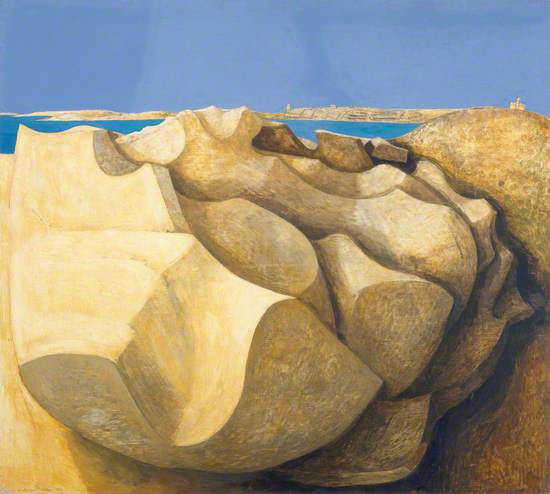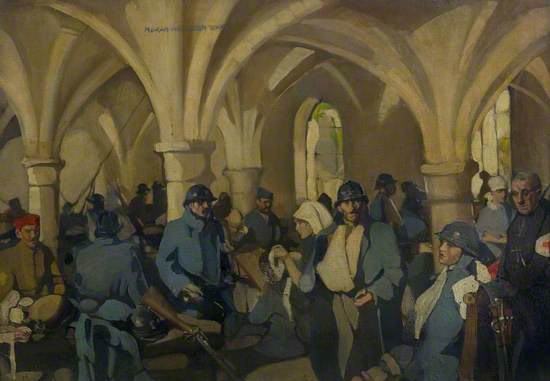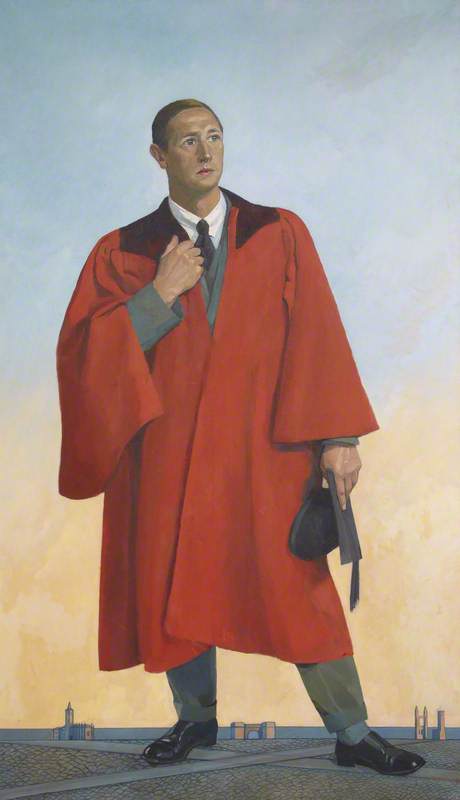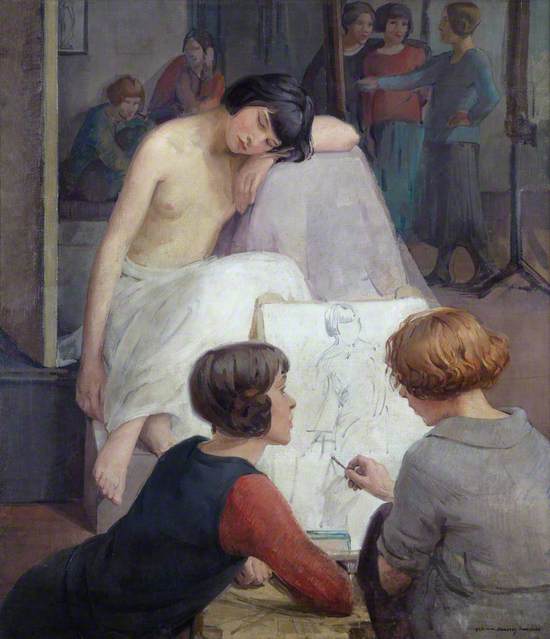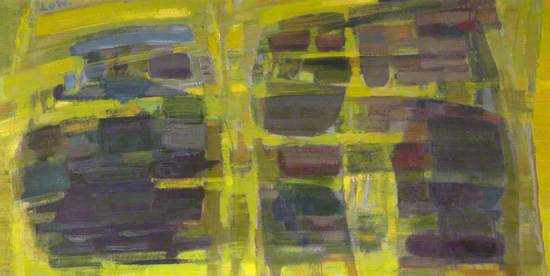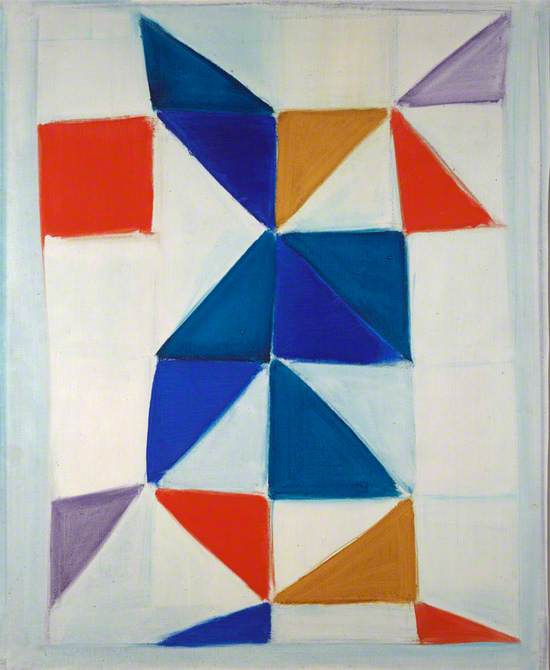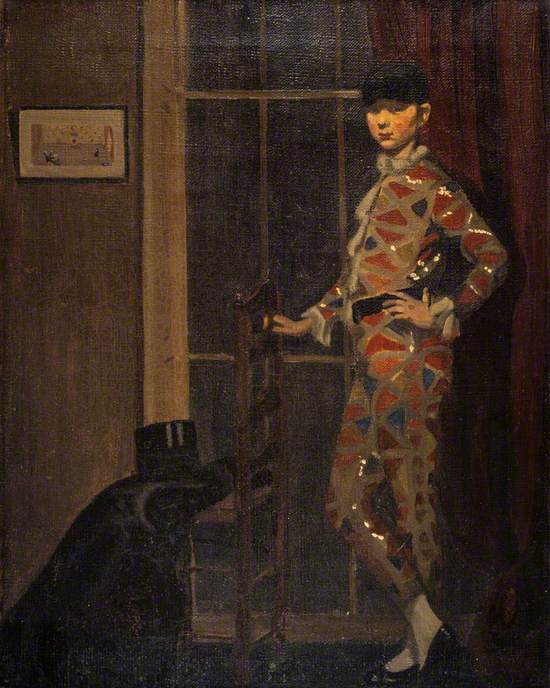To mark International Women's Day, I present a dozen modern Scottish women painters I think you should know.
The artists are listed in alphabetical order by surname, from Wilhelmina Barns-Graham to Anna Zinkeisen. They range from Mabel Pryde Nicholson, who was born in 1871, to Pat Douthwaite, who was born in 1934 (though she always gave her birth date as 1939).
The works featured cover the period 1910 to 1990. They include genres from portraiture to abstraction, by way of war service, political comment, response to nature and humorous observation.
I have used a generous definition of Scottish, whether by birth, training or residence as a child or adult.
You can find out more the featured artists on Art UK. Enjoy!
1953
Rocks, St Mary's, Scilly Isles
Wilhelmina Barns-Graham was born in St Andrews in 1912. She trained at Edinburgh College of Art - against her father's wishes, but with the financial support of an aunt. On the renewal of a scholarship in 1940, she moved to Cornwall where - through her art college friend Margaret Mellis (see below) - she became a member of what is now known as the 'St Ives School' and emerged as a pioneer of British abstraction.
This work is based on drawings made in largest of the islands in the archipelago off the southwestern tip of Cornwall. Barns-Graham forcefully communicates her emotional response to her geological surroundings. A fine line is combined with light, shadow and voluptuous form which almost bursts out of the picture plane.
Wilhelmina Barns-Graham (1912–2004)
Oil on board
H 102.8 x W 114.3 cm
Museums & Galleries Edinburgh – City of Edinburgh Council
1990
Dr Helen Wright
Douthwaite was born in Glasgow in 1934. She was discouraged from attended art school by the Scottish Colourist J. D. Fergusson and as a result is essentially a self-taught ‘outsider’ artist. During a peripatetic life beset with financial and psychological challenges, Douthwaite travelled extensively, whilst considering Scotland to be her home.
This portrait from 1990 is of the wife of Douthwaite’s GP, Dr Richard Wright. A startling use of colour, flattened form and pattern exists alongside an angst-suffused depiction of Helen Wright’s facial expression and breasts – whose shape is repeated in her necklace. The whole composition is askew, with an arrow pointing towards the sitter’s elongated neck, as notions of flattery are ignored.
Pat Douthwaite (1934–2002)
Oil on canvas
H 144 x W 107 cm
Museums & Galleries Edinburgh – City of Edinburgh Council
1962
Summer Grasses and Barley on the Clifftop
Eardley was born in Sussex in 1921. She studied at Glasgow School of Art and at Hospitalfield College of Art, Arbroath. From 1954 she spent increasing amounts of time in Catterline, a fishing village on the north-east coast of Scotland. There, she worked outdoors in all weather conditions and at all times of day and night, creating land- and seascapes in which the weather, nature and mankind’s relationship with it, where her subjects.
This is a beautiful example of Eardley’s sensory response to high summer. It is painted on a monumental scale (110 x 138cm). In the foreground, rough, free and layered brushstrokes express the energy, movement and texture of crops at the zenith of their growth.
2021 is the centenary year of Eardley's birth.
Joan Kathleen Harding Eardley (1921–1963)
Oil on board
H 110.2 x W 137.8 cm
Museums & Galleries Edinburgh – City of Edinburgh Council
Hopital Auxiliaire d'Armee 301 - Abbaye de Royaumont
Norah Neilson Gray was born in Helensburgh in 1882. She studied at Glasgow School of Art, where she later taught fashion design and drawing. She established a successful practice as a portrait painter and exhibited internationally. In 1921, Gray became the first woman appointed to the Hanging Committee of the Royal Glasgow Institute of the Fine Arts.
During World War One, Gray worked in one of the Scottish Women's Hospitals in France. This painting depicts the soldiers in the busy casualty reception area of the hospital's medieval cloister. After the war, Gray did not want this work to be acquired by the Women's Work sub-committee of the Imperial War Museum, resisting categorisation as a 'woman artist'.
Norah Neilson Gray (1882–1931)
Oil on canvas
H 71 x W 98 cm
Argyll and Bute Council
The Student
Huntington was born in St Andrews in 1889. She trained as both an artist and as a musician, including in Dundee under the painter William ‘Spanish’ Macdonald, whom she married in 1925. In 1929 they moved to Edinburgh, where she established a celebrated salon and died, aged ninety-nine, having hosted a late-night party.Huntington's career was at its zenith in the 1930s and 1940s, when she was celebrated as a portrait painter.
This painting depicts a St Andrew’s University student resplendent in red academic gown, its colour heightened by the plain background. The work’s elongated format accentuates his confident pose and gigantic proportions; he towers over the university town in an manipulation of scale key to his characterisation.
Beatrice M. L. Huntington (1889–1988)
Oil on canvas
H 194 x W 109 cm
University of St Andrews
Rest Time in the Life Class
Johnstone was born in Edinburgh in 1892 and attended Edinburgh College of Art. She joined its staff in 1914, but on marrying her colleague D. M. Sutherland in 1924 was obliged to resign due to the 'Marriage Bar' legislation. This forbade married women from holding full-time teaching positions and was repealed in Scotland in 1945.
This painting celebrates the ability of female students to attend a (segregated) Life Class, forbidden to them in Edinburgh until 1910 due to concerns over their viewing of naked bodies. Female students, a female model and a female teacher (a rare self-portrait at the upper right) are painted with warmth and triumph in what is widely considered to be Johnstone's masterpiece.
Dorothy Johnstone (1892–1980)
Oil on canvas
H 121.5 x W 106.2 cm
Museums & Galleries Edinburgh – City of Edinburgh Council
Merge and Emerge
Low was born in Gourock in 1924. She trained at Glasgow School of Art and Hospitalfield College of Art, Arbroath.In 1963 she was a co-founder of the not-for-profit New Charing Cross Gallery in Glasgow, in order to provide exhibiting opportunities for young practitioners. She founded the Bet Low Trust which supports students and artists in Scotland in the fields of drawing and painting.
This painting comes from a series based on the movement of water, in this case over stones in a riverbed whose level of visibility is dependent on the ebb and flow of the surrounding water. There is a strong rhythmic quality to the brushstrokes and fields of layered colour, which explore notions of opaqueness and transparency and of fluidity and solidity.
Bet Low (1924–2007)
Oil on canvas
H 60 x W 121 cm
Museums & Galleries Edinburgh – City of Edinburgh Council
White Painting (with Red, Blue, Violet and Ochre)
Mellis was born in Wukingfu, China in 1914. She studied at Edinburgh College of Art, under André Lhote in Paris and at the Euston Road School in London. In 1939, Mellis and her husband moved to Carbis Bay, Cornwall and were part of the founding of the 'St Ives School’. Mellis later lived in France before settling in Suffolk, from where she exhibited internationally and made the celebrated driftwood constructions of her late career.
Mellis’s interest in geometry and colour relationships is clear in this work. The varied rhythm of square and triangular elements is emphasised by the balance of gentle hues and forceful tones of its palette. It plays between notions of two and three dimensions and is an accomplished example of abstraction.
Margaret Mellis (1914–2009)
Oil on hardboard
H 122 x W 101.6 cm
National Galleries of Scotland
Nancy as the Harlequin with a Windsor Chair
Mabel Nicholson (nee Pryde) was born in Edinburgh in 1871. She studied at The Herkomer School in Bushey, Hertfordshire, where she met her husband, the artist William Nicholson. They had four children and Nicholson paid them modest fees to sit for her as domestic responsibilities permitted. She exhibited in group shows in London but her career was cut short by an early death during the Spanish influenza epidemic of 1918.
This work comes from a series of paintings in which the artist’s daughter, the designer Nancy Nicholson, is seen in the same costume, one of many kept in a dressing-up box and frequently worn by artist's sitters. The highly-coloured and patterned costume stands out amidst the low-toned palette preferred by Nicholson.
Mabel Nicholson (1871–1918)
Oil on canvas
H 51 x W 40 cm
National Galleries of Scotland
1950
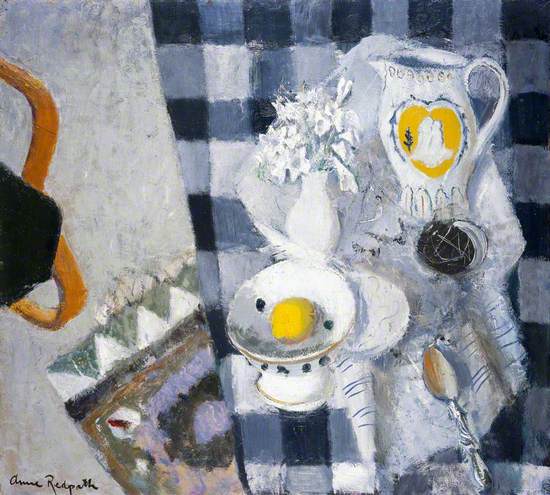
Black and White Checks
Anne Redpath was born in Galashiels in 1895. She studied at Edinburgh College of Art and lived in France between 1920 and 1934. On returning to Scotland with her children she resumed painting in earnest in the early 1940s. She built up an extremely successful career, exhibiting widely, travelling internationally and in 1952 became the first female painter to be elected a full member of the Royal Scottish Academy.
This painting is an unsually avant-garde example of the 'still-life within an interior genre for which Redpath is celebrated. Multiple viewpoints are combined, whilst layers of space, notions of depth and existence beyond the picture plane are explored. Yet throughout, a sense of the beautiful and domestic is manintained.
Anne Redpath (1895–1965)
Oil on canvas
H 77.5 x W 83.8 cm
Museums & Galleries Edinburgh – City of Edinburgh Council
1920
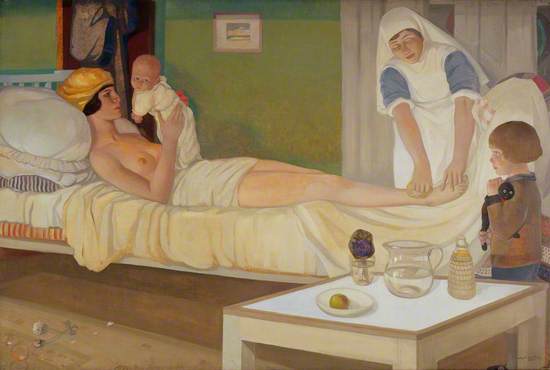
Romance
Walton was born in Glasgow in 1891. She studied at the Atelier la Grande Chaumiére and Académie de la Palette, Paris, as well as at Edinburgh College of Art. With her first husband, Eric Robertson and Dorothy Johnstone she was part of the ‘Edinburgh Group’ exhibiting society active between 1913 and 1921. Following her divorce Walton worked as a mural painter, theatre designer, illustrator and for the BBC.
This work is an exceptional self-portrait in which Walton addresses her conflicting identities as mother and artist. She is depicted shortly after giving birth to her younger son, whilst being observed by his older sibling. Walton wrote of 'the tragedy that attends so often the attempt to reconcile career and domestic life.'
Cecile Walton (1891–1956)
Oil on canvas
H 100.6 x W 150.9 cm
National Galleries of Scotland
1935
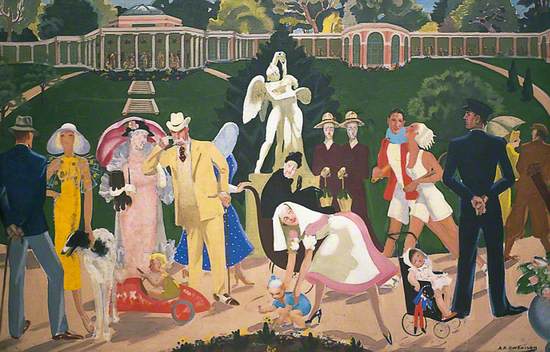
Valley Gardens with the Sun Pavilion in the Background
Zinkeisen was born in Kilcreggan in 1901. She trained at Harrow School of Art and at the Royal Academy Schools in London. After graduating, Zinkeisen specialised in portrait painting and mural work, including for some of the most prestigious liners of the 1930s. During World War Two, she worked as a nurse in a London hospital and painted her experiences. Her post-war portrait sitters included members of the Royal Family and the British aristocracy.
This work depicts the popular Valley Gardens park in Harrogate. The newly constructed Sun Pavilion provides the background, whilst the foreground is crowded with humorously observed set pieces from ananny with her charges to dashing tennis players, all enjoying the benefit of being outdoors.
Anna Katrina Zinkeisen (1901–1976)
Oil on canvas
H 74 x W 114.3 cm
The Mercer Art Gallery, Harrogate
Explore artists in this Curation
View all 12-
 Mabel Nicholson (1871–1918)
Mabel Nicholson (1871–1918) -
 Anna Katrina Zinkeisen (1901–1976)
Anna Katrina Zinkeisen (1901–1976) -
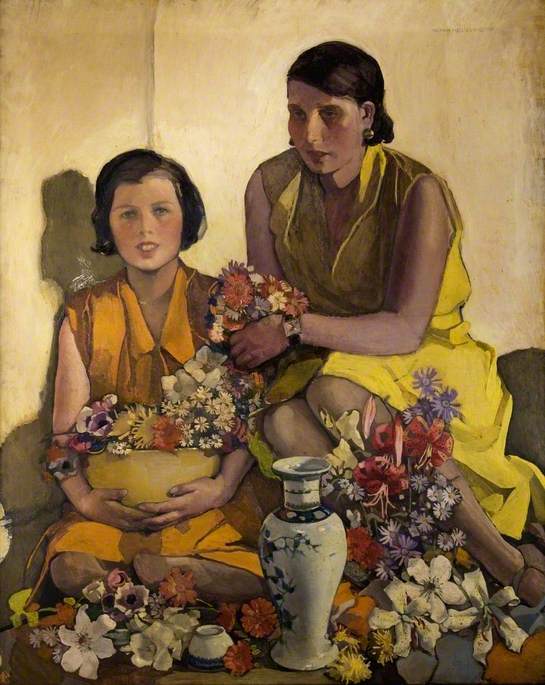 Norah Neilson Gray (1882–1931)
Norah Neilson Gray (1882–1931) -
 Bet Low (1924–2007)
Bet Low (1924–2007) -
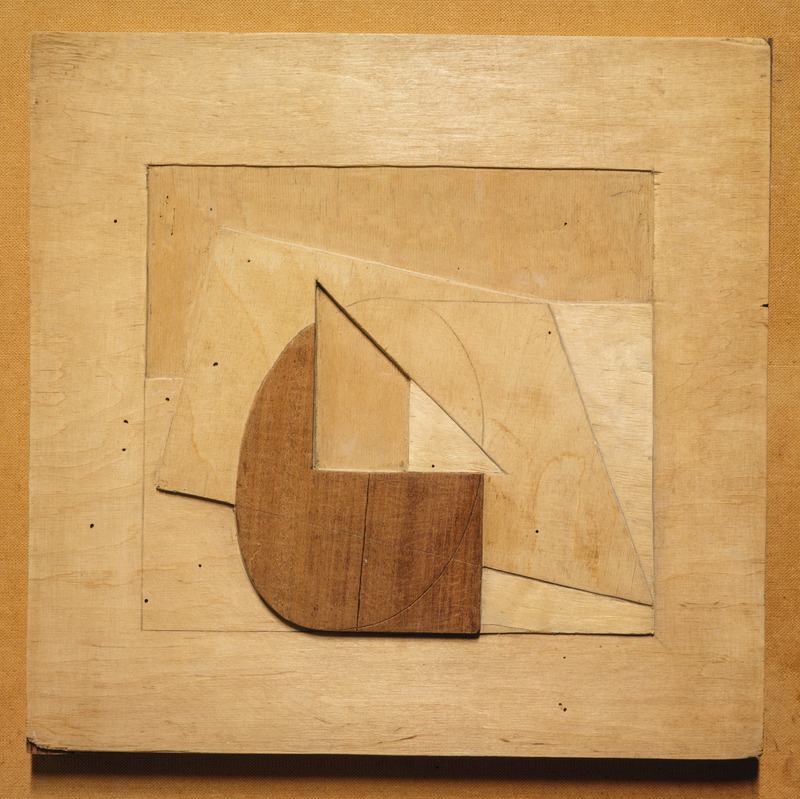 Margaret Mellis (1914–2009)
Margaret Mellis (1914–2009) -
 Joan Kathleen Harding Eardley (1921–1963)
Joan Kathleen Harding Eardley (1921–1963) -
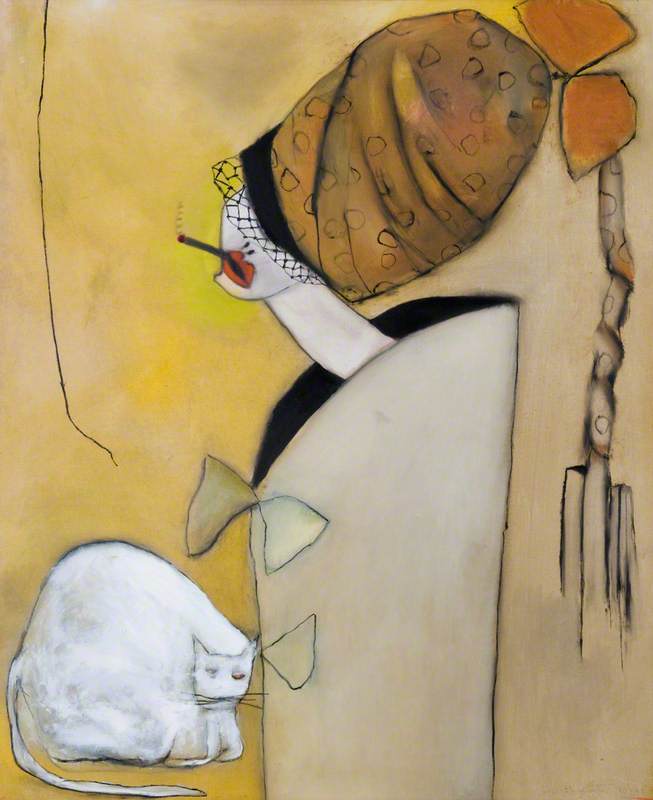 Pat Douthwaite (1934–2002)
Pat Douthwaite (1934–2002) -
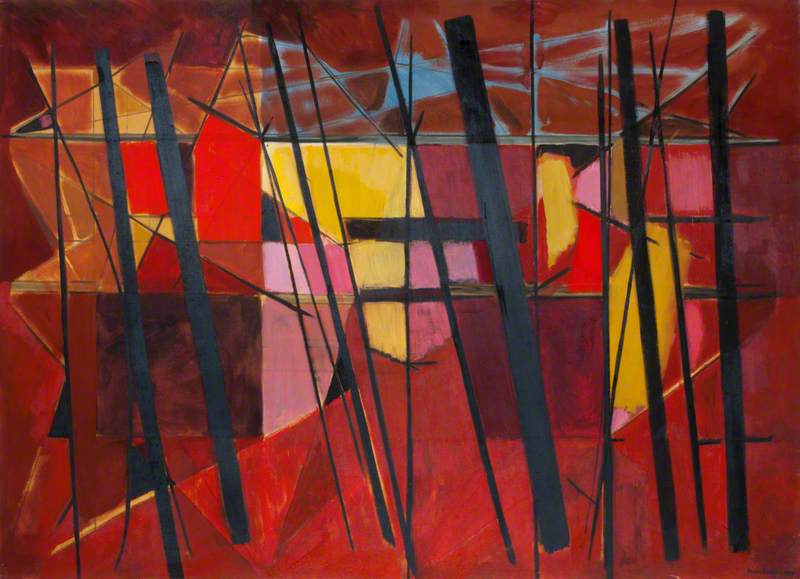 Wilhelmina Barns-Graham (1912–2004)
Wilhelmina Barns-Graham (1912–2004) -
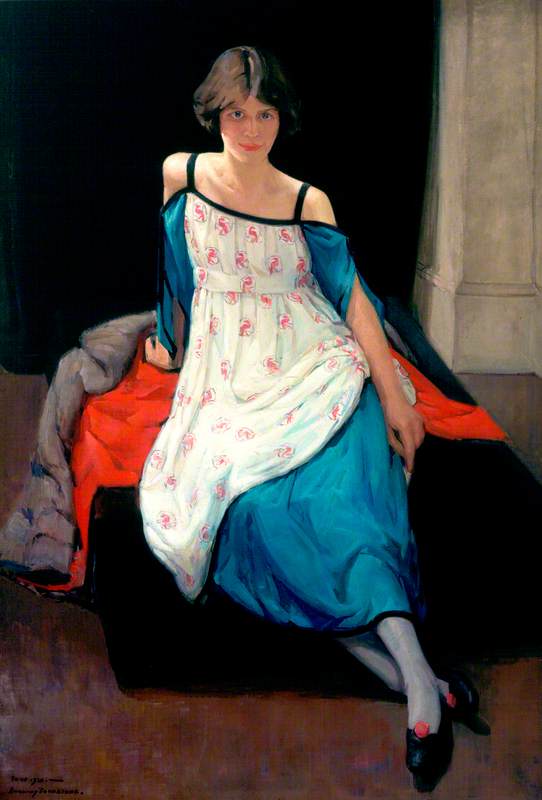 Dorothy Johnstone (1892–1980)
Dorothy Johnstone (1892–1980) -
 Cecile Walton (1891–1956)
Cecile Walton (1891–1956) - View all 12
